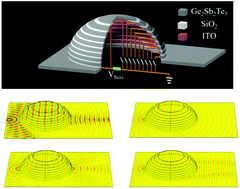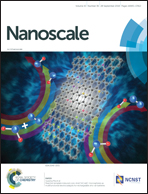A reprogrammable multifunctional chalcogenide guided-wave lens†
Abstract
The transformation optics (TO) technique, which establishes an equivalence between a curved space and a spatial distribution of inhomogeneous constitutive parameters, has enabled an extraordinary paradigm for manipulating wave propagation. However, extreme constitutive parameters, as well as a static nature, inherently limit the simultaneous achievement of broadband performance, ultrafast reconfigurability and versatile reprogrammable functions. Here, we integrate the TO technique with an active phase-change chalcogenide to achieve a reconfigurable multi-mode guided-wave lens. The lens is made of a Rinehart-shaped curved waveguide with an effective refractive index gradient profile through partially crystallizing Ge2Sb2Te5. Upon changing the bias time of the external voltage imparted to the Ge2Sb2Te5 segments, the refractive index gradient profile can be tuned with a transformative platform for various functions for visible light. The electrically reprogrammable multi-mode guided-wave lens is capable of dynamically acquiring various functionalities with an ultrafast response time. Our findings may offer a significant step forward by providing a universal method to obtain ultrafast and highly versatile guided-wave manipulation, such as in Einstein rings, cloaking, Maxwell fish-eye lenses and Luneburg lenses.



 Please wait while we load your content...
Please wait while we load your content...